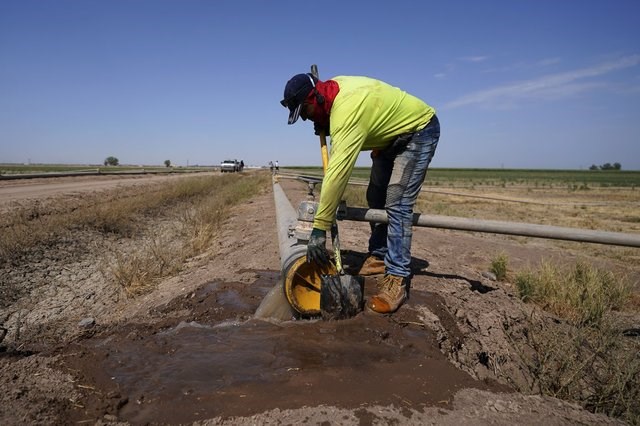A plan to help shore up the depleted Colorado River by cutting off water to alfalfa fields in California's crop-rich Imperial Valley is finding support from the farmers who grow it.
The Imperial Irrigation District — the biggest user of water from the 1,450-mile (2,334-kilometer) river — has offered to pay farmers to shut off irrigation to forage crops including alfalfa for up to 60 days during the peak of the sweltering summer. While farmers often balk at the idea of letting fields lie fallow, at least 80% of properties eligible for the new program have been signed up to participate, said Tina Shields, the district's water department manager.
“We don't like to do fallowing down here,” Shields said. “They're making business decisions.”
The move comes as farmers of alfalfa and other crops that feed cattle have seen the price of hay plummet amid rising supply. For many, that means a summer crop of alfalfa could bring in less in revenue than the $300 in federal funding per acre-foot of water that the water district is willing to fork over if they simply stop watering it, experts said.
From California to Arkansas, farmers have reported a stellar year for hay and many are scrambling to find buyers or deciding whether it's worth paying to store it, said Sue Arnold, executive director of the Ohio-based National Hay Association.
“They have a lot more hay than they typically have this time of year so their barns are full,” she said of the organization’s members. “They’re scared, ‘I am going to have all this inventory.’”
Hay exporters are struggling with the strong U.S. dollar and some overseas markets are willing to take a lower quality product than the top notch hay grown in the United States, especially in the Imperial Valley, Arnold said.
The idea to pay the farmers to halt irrigation arose last year as part of an agreement among Arizona, Nevada and California to aid the dwindling Colorado River, which provides water to 40 million people in seven U.S. states, parts of Mexico and more than two dozen Native American tribes — and saw water levels decline during a punishing drought.
Under the plan, the federal government agreed to spend $1.2 billion for users to temporarily scale back their water use. The goal was to conserve an additional 3 million acre-feet of water through 2026 — with more than half of those cuts coming from California — when current guidelines for how the river is shared expire.
The Imperial Irrigation District, which is California's biggest user of Colorado River water, drafted the voluntary program for farmers to temporarily stop watering Alfalfa, Bermuda grass, or Klein grass in the summer — crops that can withstand going dry for a short while. The idea is to do so when yields are already down in summer, more water is required and dairies tend to keep their number of head low.
The district had proposed to roll out the program in the spring but faced delays over environmental concerns including the fate of the tiny, endangered desert pupfish, which thrives on irrigation runoff. Environmental approvals are still pending but the district opted to sign up takers for the program now to save time, Shields said.
So far, the program has applications from about 170 different businesses covering nearly 160,000 acres (64,750 hectares) of fields, which could conserve about 215,000 acre feet of water, she said.
Trevor Tagg, a hay farmer in the Imperial Valley, is among many opting for the program. He said alfalfa prices have plummeted in the past two years as supply has risen and farmers are left with little choice but to keep growing on fields hoping that prices rise in the future. He said he and many others sat down and did the math — what the water district is offering is a better shot than what he can get cutting the crop right now.
A couple of years ago, he said a ton of hay could command $400 but might now only fetch $100.
“The pendulum is swinging really hard,” he said. “Things have been really tough. You are seeing farms on the brink of bankruptcy — many, many of them.”
Tough times force farmers to make difficult choices and turning off the water for a month or two is seen as a better option than fallowing fields for longer and walloping the local economy, where equipment suppliers and local restaurants also depend on farming for their livelihoods. About a quarter of Imperial County's farm production comes from field crops, according to a county agricultural report.
“It keeps us farming for another day," Tagg said. "It supports the river, it supports Lake Mead. It supports everything we're trying to do.”
“It's not perfect for anybody," he said.
Amy Taxin, The Associated Press




